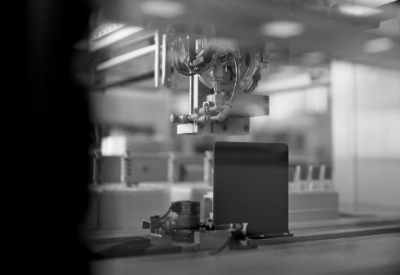
Have you ever wondered how your phone keeps track of time when it runs out of battery? Or how data can remain on a hard drive even if all the power in the building goes out? Basically, the devices we use are made of countless components working together, some of which don’t stop when the power supply does.
Tiny microcontrollers powered by microbatteries keep low-power, essential functions going, even when a device is powered off. Understanding how these systems work—and how they can be improved—is an integral part of developing new technologies.
What Are Microcontrollers?
A microcontroller is part of an embedded system designed to handle specific operations. It’s a compact integrated circuit that comprises a processor, memory, and input/output (I/O) peripherals.
Each component carries out a particular function.
- CPU processor: The processor is the microcontroller’s command center. It handles all the instructions that direct function in the device. This could mean performing basic operations and transferring data to communicate commands with the rest of the system.
- Memory: There are two main memory types in a microcontroller—program and data memory. Program memory is non-volatile, meaning it holds information even when there is no power source. This allows the microcontroller to store long-term information for the CPU’s core processes. Data memory is volatile and requires a constant energy supply. This data storage is necessary while instructions are being executed in the embedded system.
- Peripherals: Input and output devices make up the interface between the processor and the rest of the world. Input ports take information in and convert it to binary data for the processor. That data is then output to other devices that execute a variety of tasks.
A microcontroller is essentially a mini-computer on a single chip.
How Do Microcontrollers Work?
These computers can control small features of a larger device with no complex operating system.
The microcontroller uses its central processor to interpret data from the I/O peripherals. The received information stored in data memory is deciphered to apply all subsequent actions.
A microcontroller is very similar to a microprocessor, but it’s slightly more independent. Microcontrollers often function with a direct connection to sensors and actuators, while microprocessors rely more on additional connections. A microprocessor has a higher computing power than a microcontroller, which is why those are more common in certain devices, such as a desktop computer.
Types of Microcontrollers
There are multiple ways to classify microcontrollers. They can be divided by their instruction sets, architecture, memory capabilities, and bits. Different bit values indicate the following functions:
- 8-bit microcontrollers can perform logic and arithmetic operations.
- 16-bit microcontrollers perform logic and arithmetic operations with greater accuracy and performance.
- 32-bit microcontrollers are used in automatically controlled appliances and need specific instructions to perform logic and arithmetic operations.
The more complex operations that a chip must perform, the higher the bit value and necessary power.
Below are the common types of microcontrollers differentiated by architecture.
Microcontroller 8051
The most widely used microcontrollers are those in the 8051 family. 8051s are a type of 8-bit microcontroller launched by Intel Corporation in 1981. They have ROM storage, RAM storage, four parallel programmable 8-bit ports, and 40 pins. They can be used in a variety of devices and offer good, reliable performance.
PIC Microcontroller
PIC microcontrollers, or peripheral interface controllers, were developed by Microchip Technology primarily for categorizing solitary chip microcontrollers. The company has been constantly upgrading the 8-bit PIC chip to match it with clientele necessities. These are used for preparing different I/O purposes and methods.
ARM Microcontroller
The ARM is an Advanced RISC Machine—RISC meaning reduced instruction set computer—that uses the most popular type of microcontroller processing in the world of digital embedded systems. ARM microcontrollers are high-performance and cost-sensitive, often used because of their product implementation features.
AVR Microcontroller
The AVR microcontroller, named after its creators and function (Alf-Egil Bogen, Vegard Wollan, and RISC) is also called Advanced Virtual RISC. This is an 8-bit processor developed at Harvard and based on AVR architecture.
AVR microcontrollers are almost four times faster than PICs. They execute most instructions in one single execution cycle. They also have multiple power saving modes and consume less power altogether.
MSP Microcontroller
From the Texas Instruments family, the mixed signal processor is built around a 16-bit CPU. It’s made for low-power dissipation systems and low-cost practices. Its 16-bit data processing capabilities, additional modes, and denser programming code allow the MSP to perform quicker than alternatives.
Microcontroller Applications
A microcontroller is often viewed as a set of self-contained systems with memory and processor. Most of these controllers are harnessed for the development and use of other, larger devices.
Microcontrollers are cheap and small, making them a very convenient component; their programming is relatively simple, so learning the technology isn’t too difficult; and they allow us to control and work on embedded systems remotely. All of which means they can be used in almost any complex technological device to improve functionality and maintenance. This includes tools in many industries, such as robotics, automotive, home and enterprise, automation, communications, smart energy, etc..
One application of a microcontroller might be in a digital signal processor. Analog signals often come with different levels and frequencies of noise. The digital signal processor uses its parts to convert the noises into standard digital values.
Microcontroller Examples
Basic microcontrollers are used in everyday items like toasters, televisions, refrigerators, and even small devices like key fobs. Every time you use an office machine like a scanner, copier, or printer, you are likely activating several of these tiny computers.
More complex microcontrollers help us operate large vehicles, life-support systems, and even spacecrafts. The possibilities for this technology are always evolving.
Some other examples of devices that microcontrollers are used in include the following:
- Appliances
- Automobiles
- Cameras
- Computers/computer systems
- Electronic measurement instruments
- Microwaves
- Phones
Security alarmsAs microcontrollers get smaller and more efficient—which they will continue to do—their uses will only increase. Corresponding technological advances must be able to sustain these new devices. This is one reason why City Labs has developed long-lasting NanoTritium™ batteries to power low-energy microelectronics.
Microcontroller Batteries
Microcontrollers cannot function without a power supply. They have no built-in battery, meaning they are powered with external sources. The goal is to have an energy source that outputs the microcontroller’s required current and voltage.
While microcontrollers can often be powered by a direct or alternating current, for added security, many developers use external batteries to support necessary functions. If there is a power outage, or a physical malfunction with the DC/AC power supply, you may lose valuable information from the microcontroller (or the system in which it is embedded).
Additionally, batteries enable devices to go cordless. A device that doesn’t need to be plugged into a wall can be more easily transported.
Long-Term Reliable Power Sources for Microcontrollers
When using current microcontroller battery technology, there are certain limitations because a battery can only provide so much power for so long. What’s the point of creating a battery-powered microcontroller that you have to replace regularly?
Electrochemical microcontroller batteries only last a fraction of the time that newer betavoltaic power sources do—and they degrade from frequent usage.
Use City Labs NanoTritium™ Batteries to Power Microcontrollers
Our tritium battery products have been tested to last longer than two decades and perform without permanent degradation under extreme external conditions. These innovations could allow for the use of microcontrollers in remote locations that are not easily accessible for maintenance. Imagine a self-powered, autonomous microcontroller that can operate for over 20 years under a broad range of temperature, vibration, and other environmental conditions.
As we continue developing our microcontroller battery technology, we are constantly on the lookout for additional scientific and commercial partners. If you believe your technology or product could benefit from long-lasting low power betavoltaic power sources, do not hesitate to reach out to the City Labs’ team today.
The Nuclear Battery Company With a Vision
Ready to power your next innovation or learn more about our technology?
Contact Us Today



